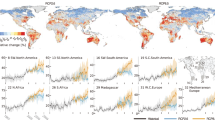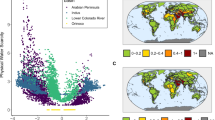Abstract
Growing evidence suggests that drought risk is increasing due to climate change. Evaluation of potential policy responses involves understanding complex economic tradeoffs, hydrologic and social feedbacks, and recognizing how combinations of interventions may have complementary or conflicting effects. This paper explores the potential that coupled human–natural system models have to address these questions. We employ a detailed model of the Willamette River Basin, Oregon, to evaluate the effectiveness of a variety of potential drought policy interventions to conserve or reallocate water during a simulated near-term drought year. The drought year is characterized by early-season low flows that make it impossible to meet water demands. The results indicate that while the policies are effective at conserving water, they have limited ability to mitigate the shortages because the timing and location of conservation responses do not match the timing and location of the shortages.
This is a preview of subscription content, access via your institution
Access options
Access Nature and 54 other Nature Portfolio journals
Get Nature+, our best-value online-access subscription
$29.99 / 30 days
cancel any time
Subscribe to this journal
Receive 12 digital issues and online access to articles
$119.00 per year
only $9.92 per issue
Buy this article
- Purchase on Springer Link
- Instant access to full article PDF
Prices may be subject to local taxes which are calculated during checkout





Similar content being viewed by others
Data availability
Details of the Willamette Envision models and scenarios used for the analysis described in this paper can be found at http://inr.oregonstate.edu/ww2100/data.
References
Diffenbaugh, N. S., Swain, D. L. & Touma, D. Anthropogenic warming has increased drought risk in California. Proc. Natl Acad. Sci. USA 112, 3931–3936 (2015).
IPCC Climate Change 2013: The Physical Science Basis (eds Stocker, T. F. et al.) (Cambridge Univ. Press, 2013).
Van Loon, A. F. et al. Drought in the Anthropocene. Nat. Geosci. 9, 89 (2016).
Chang, H. & Jung, I.-W. Spatial and temporal changes in runoff caused by climate change in a complex large river basin in Oregon. J. Hydrol. 388, 186–207 (2010).
Jaeger, W. K. et al. Finding water scarcity amid abundance using human–natural system models. Proc. Natl Acad. Sci. USA 114, 11884–11889 (2017).
Amos, A. L. Developing the law of the river: the integration of law and policy into hydrologic and socio-economic modeling efforts in the Willamette River Basin. Univ. Kans. Law Rev. 62, 1091 (2013).
Levin, S. et al. Social-ecological systems as complex adaptive systems: modeling and policy implications. Environ. Dev. Econ. 18, 111–132 (2013).
Cai, X., McKinney, D. C. & Lasdon, L. S. Integrated hydrologic-agronomic-economic model for river basin management. J. Water Resour. Plan. Manage. 129, 4–17 (2003).
Bateman, I. et al. Bringing ecosystem services into economic decision-making: land use in the United Kingdom. Science 341, 45–50 (2013).
Rabotyagov, S. S. et al. Cost-effective targeting of conservation investments to reduce the northern Gulf of Mexico hypoxic zone. Proc. Natl Acad. Sci. USA 111, 18530–18535 (2014).
IPCC Climate Change 2014: Impacts, Adaptation, and Vulnerability (eds Field, C. B. et al.) (Cambridge Univ. Press, 2014).
Turner, D. P., Conklin, D. R. & Bolte, J. P. Projected climate change impacts on forest land cover and land use over the Willamette River Basin, Oregon, USA. Clim. Change 133, 335–348 (2015).
Bigelow, D. P., Plantinga, A. J., Lewis, D. J. & Langpap, C. How does urbanization affect water withdrawals?Insights from an econometric-based landscape simulation. Land Econ. 93, 413–436 (2017).
Lewis, D. J., Plantinga, A. J., Nelson, E. & Polasky, S. The efficiency of voluntary incentive policies for preventing biodiversity loss. Resour. Energy Econ. 33, 192–211 (2011).
Kalinin, A. V. Right as Rain? The Value of Water in Willamette Valley Agriculture (Oregon State Univ., 2013).
Seibert, J. Estimation of parameter uncertainty in the HBV model. Nord. Hydrol. 28, 247–262 (1997).
Turner, D. P. et al. Assessing mechanisms of climate change impact on the upland forest water balance of the Willamette River Basin, Oregon. Ecohydrology 10, e1776 (2017).
Allen, R. G. & Robison, C. W. Evapotranspiration and Consumptive Irrigation Water Requirements for Idaho (Univ. of Idaho Research and Extension, 2007).
Allen, R. G., Pereira, L. S., Raes, D. & Smith, M. Crop Evapotranspiration – Guidelines for Computing Crop Water Requirements. Irrigation and Drainage Paper 56 (FAO, 1998).
Seibert, J. HBV Light Version 2. User’s Manual (Stockholm Univ., 2005).
Abatzoglou, J. T. Development of gridded surface meteorological data for ecological applications and modelling. Int. J. Climatol. 33, 121–131 (2013).
Rupp, D. E., Abatzoglou, J. T., Hegewisch, K. C. & Mote, P. W. Evaluation of CMIP5 20th century climate simulations for the Pacific Northwest USA. J. Geophys. Res. Atmos. 118, 10,884–10,906 (2013).
Vano, J. A., Kim, J. B., Rupp, D. E. & Mote, P. W. Selecting climate change scenarios using impact-relevant sensitivities. Geophys. Res. Lett. 42, 5516–5525 (2015).
Wilhite, D. A. Drought policy in the U.S. and Australia: a comparative analysis. J. Am. Water Resour. Assoc. 22, 425–438 (1986).
Drought Management and Its Impact on Public Water Systems (National Research Council, 1986).
Willamette River Basin Project Biological Opinion (NMFS, 2008).
Moore, K. M. Optimizing Reservoir Operations to Adapt to 21st Century Expectations of Climate and Social Change in the Willamette River Basin, Oregon (Oregon State Univ., 2015).
Harrison, J. Warm Water Blamed for Huge Columbia River Sockeye Die-off (Northwest Power and Conservation Council, 2015).
Faulkner, J. R., Widener, D. L., Smith, S. G., Marsh, T. M. & Zabel, R. W. Survival Estimates for the Passage of Spring-Migrating Juvenile Salmonids through Snake and Columbia River Dams and Reservoirs, 2015 (National Marine Fisheries Service for the Bonneville Power Administration, 2016).
Statistical Report for Fiscal year 2016–2017 (Portland Water Bureau, 2017).
US Community Water System Survey 2000 Vol. 1: Overview (EPA, 2002); www.epa.gov/safewater
U. S. Water Supply and Use in the United States 2008 (EPA, 2008); www.epa.gov/watersense
Wichman, C. J., Taylor, L. O. & von Haefen, R. H. Conservation policies: who responds to price and who responds to prescription? J. Environ. Econ. Manag. 79, 114–134 (2016).
Mini, C., Hogue, T. S. & Pincetl, S. The effectiveness of water conservation measures on summer residential water use in Los Angeles, California. Resour. Conserv. Recycl. 94, 136–145 (2015).
Bland, A. Californians are struggling to pay for rising water rates—water deeply. NewsDeeply https://www.newsdeeply.com/water/articles/2018/02/27/californians-are-struggling-to-pay-for-rising-water-rates (2018).
Postel, S. L., Daily, G. C. & Ehrlich, P. R. Human appropriation of renewable fresh water. Science 271, 785–788 (1996).
Scheierling, S. M., Loomis, J. B. & Young, R. A. Irrigation water demand: a meta-analysis of price elasticities. Water Resour. Res. 42, W01411 (2006).
Huffaker, R. & Whittlesey, N. A theoretical analysis of economic incentive policies encouraging agricultural water conservation. Int. J. Water Resour. Dev. 19, 37–53 (2003).
Kelley, A. K. & Beck, R. E. Waters and Water Rights (LexisNexis, 2009).
National Hydrography Dataset (US Geological Survey (USGS), accessed 21 September 2018); http://www.horizon-systems.com/NHDPlus/NHDPlusV2_home.php
Bennear, L. S., Lee, J. M. & Taylor, L. O. Municipal rebate programs for environmental retrofits: an evaluation of additionality and cost-effectiveness. J. Policy Anal. Manage. 32, 350–372 (2013).
Mansur, E. T. & Olmstead, S. M. The value of scarce water: measuring the inefficiency of municipal regulations. J. Urban Econ. 71, 332–346 (2012).
Brent, D. A., Cook, J. H. & Olsen, S. Social comparisons, household water use, and participation in utility conservation programs: evidence from three randomized trials. J. Assoc. Environ. Resour. Econ. 2, 597–627 (2015).
Olmstead, S. M. The economics of managing scarce water resources. Rev. Environ. Econ. Policy 4, 179–198 (2010).
Biological Opinion on the Continued Operation and Maintenance of the Willamette River Basin Project and Effects to Oregon Chub, Bull Trout, and Bull Trout Critical Habitat Designated Under the Endangered Species Act (US Fish and Wildlife Service, 2008).
Amos, A. Freshwater conservation in the context of energy and climate policy: assessing progress and identifying challenges in Oregon and the Western United States. Univ. Denv. Water Law Rev. 12, 1–22 (2008).
Getches, D., Zellmer, S. & Amos, A. Water Law in a Nutshell 5th edn (West Academic, 2015).
Acknowledgements
This project was supported by the National Science Foundation (grant Nos. 1039192 (Oregon State University), 1038925 (Portland State University) and 1038899 (University of Oregon)). We also acknowledge support from NOAA’s Climate Program Office under cooperative agreement No. NA15OAR4310145.
Author information
Authors and Affiliations
Contributions
All authors contributed equally.
Corresponding author
Ethics declarations
Competing interests
The authors declare no competing interests.
Additional information
Publisher’s note: Springer Nature remains neutral with regard to jurisdictional claims in published maps and institutional affiliations.
Supplementary information
Supplementary Information
Supplementary Methods, References 1–26, Tables 1–7 and Figs. 1–4.
Rights and permissions
About this article
Cite this article
Jaeger, W.K., Amos, A., Conklin, D.R. et al. Scope and limitations of drought management within complex human–natural systems. Nat Sustain 2, 710–717 (2019). https://doi.org/10.1038/s41893-019-0326-y
Received:
Accepted:
Published:
Issue Date:
DOI: https://doi.org/10.1038/s41893-019-0326-y
This article is cited by
-
Multiscale analysis of drought, heatwaves, and compound events in the Brazilian Pantanal in 2019–2021
Theoretical and Applied Climatology (2024)
-
Exogenous moisture deficit fuels drought risks across China
npj Climate and Atmospheric Science (2023)
-
Future socio-ecosystem productivity threatened by compound drought–heatwave events
Nature Sustainability (2023)
-
Identifying areas of high drought risk in southwest Western Australia
Natural Hazards (2023)
-
Expanding the scope of biogeochemical research to accelerate atmospheric carbon capture
Biogeochemistry (2022)



